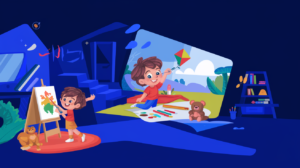Children with ADHD often feel bored because their brains need lots of activity and change. Boredom can lead to frustration and make it hard for kids to focus on tasks like schoolwork or quiet play. Research shows that with the right mix of activities and structure, children with ADHD can learn to manage boredom and enjoy their day.
Understanding ADHD and Boredom
Attention Deficit Hyperactivity Disorder, or ADHD, is a condition where children may have difficulty staying focused and may need to move around more than other kids. Their brains are wired to look for new stimulation, so tasks that are slow or repetitive can become boring quickly. Studies suggest that kids with ADHD benefit from changing tasks often and having short breaks. This variety not only helps keep their minds engaged but also supports better concentration over time.
Practical Strategies to Beat Boredom
One effective way to help kids with ADHD is to mix up activities throughout the day. Instead of spending a long time on one task, consider switching between different types of activities. For instance, after 15 minutes of reading, encourage a short break for a fun game or a creative craft project. This variety keeps the brain active and interested, making it easier for the child to transition back to more structured tasks.
Creating a Flexible Schedule with Breaks
A daily schedule that includes built-in breaks can be very helpful. Short periods of focused work followed by bursts of movement or play reduce boredom and help manage energy levels. Having a clear plan gives children a sense of security and helps them know when it’s time to focus and when it’s okay to relax. Research supports that structured routines, with some flexibility, can improve attention and reduce the frustration that comes with boredom.
Choosing Hands-On, Fun Tasks
Activities that involve doing rather than just watching are very engaging for children with ADHD. Consider art projects like drawing, painting, or building models with clay. Cooking simple recipes together can also be a fun and educational way to keep your child interested. Hands-on tasks allow for creativity and help children learn new skills while keeping their attention focused on something enjoyable.
Encouraging Movement
Many children with ADHD need to move around to feel balanced. Physical activities like dancing, playing tag, or even a short walk outside are great ways to burn off extra energy. Movement not only helps to refresh their minds but also prepares them for the next task. Regular physical activity has been shown in research to improve concentration and reduce symptoms of ADHD, making it an essential part of any daily routine.
Let Your Child Help Plan the Day
When children are involved in planning their own activities, they feel more in control of their day. Ask your child what activities they enjoy and include their ideas in your daily schedule. This simple step boosts their interest and makes them more willing to participate in the planned activities. Empowering your child in this way can reduce boredom and help them feel more confident in managing their time.
Creating a Calm Down Space
Sometimes, too much stimulation can be overwhelming. It’s important to have a quiet corner in your home where your child can relax when things feel too busy. This calm down space might include soft lighting, a comfortable seat, and a few favorite books or puzzles. Having a designated area for quiet time helps children learn to self-soothe and manage their emotions when they feel overstimulated.
Additional Activity Ideas
There are many fun and simple activities that can keep kids with ADHD engaged. Art and crafts, such as collage making or simple painting projects, allow children to express themselves creatively. Nature walks provide an opportunity to explore the outdoors, observe interesting plants and animals, and get some fresh air. Interactive games like hide-and-seek, scavenger hunts, or simple board games can turn everyday play into an exciting adventure. Even music and dance can be a great outlet for energy, allowing kids to express themselves while staying active.
Balancing Structure with Flexibility
It’s important to have a plan for your child’s day, but also to be flexible. A very strict schedule might feel overwhelming at times, so allow room for spontaneity. Giving your child choices during their free time helps them feel heard and valued. Research shows that when children are given options, they are more engaged and less likely to become bored. Flexibility within a structured routine can be the key to a more positive daily experience.
When to Seek Extra Help
While these strategies can be very effective, every child is unique. If you notice that boredom is causing a lot of stress or leading to challenging behaviors, it might be helpful to speak with a professional. A therapist who understands ADHD can work with you to develop a personalized plan that meets your child’s specific needs. Professional guidance can offer additional support, helping both you and your child navigate the challenges of ADHD with tailored strategies and expert advice.
Boredom is a common challenge for kids with ADHD, but with a mix of varied activities, structured breaks, and plenty of movement, you can help your child feel more engaged and happy. Building a daily routine that includes flexibility and fun can lead to significant improvements in your child’s focus and overall well-being. If you’re looking for more personalized advice or support, consider reaching out to a professional who specializes in ADHD. With the right help and strategies, you can make a big difference in your child’s life, turning boredom into an opportunity for growth and creativity.
Taking small, steady steps now can lead to big improvements in how your child handles boredom. Together, we can build a brighter, more engaging future for your child.



